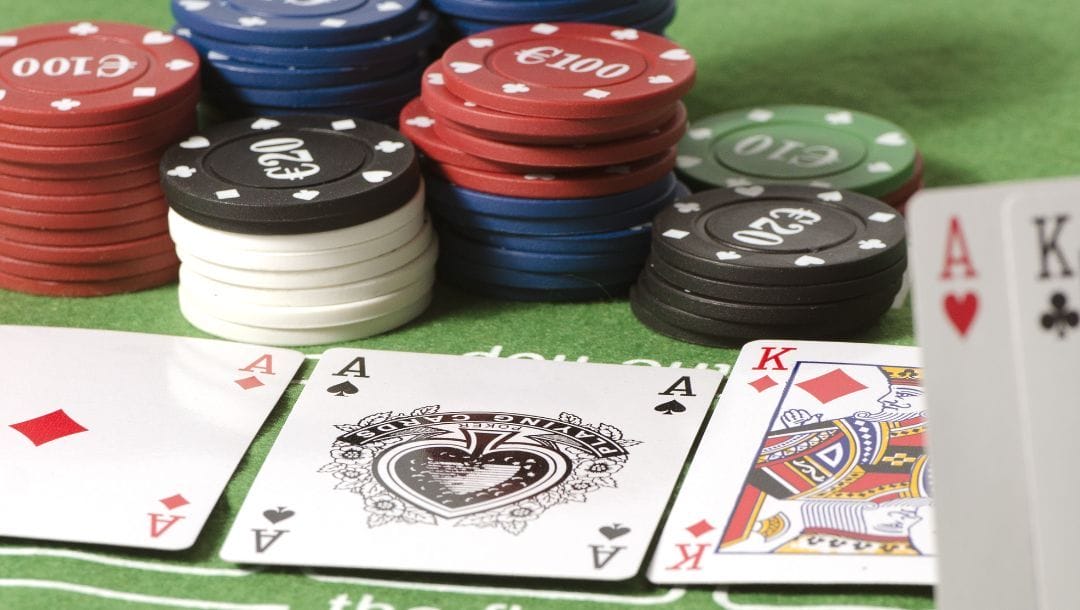When learning poker, it’s important to understand the flow of a hand. The flop is one of the most important parts of a hand. Learn what it is and how it works.
What Is a Flop in Poker and How Does It Work?

This article will teach you everything you need to know about one of the most important parts of any hand: the flop. That includes the basics, such as what it actually is and where the name comes from, as well as some pre- and post-flop strategies to consider when you play poker online.
What Is the Flop?
Flop-based poker games, such as Omaha or Texas hold’em, can be broken down into four segments. First, there is an initial round of betting that commences straight after receiving your starting hand. This includes the posting of compulsory bets, or “blinds.”
Then, five community cards are dealt in three different stages. Each has its own betting round, and these junctures are where you really start to play poker: flop, turn, river.
The first three community cards are all revealed simultaneously in what is known as a “flop.” When the betting round is finished, the fourth shared card called the “turn” card, is dealt. More betting follows before the final community card is turned face-up. This is called the “river” card.
Frequently Asked Questions
Before getting into any strategy, the following sections will address some common questions about the flop.
Where Does the Name Flop Come From?
Despite what it might sound like, a poker flop isn’t someone who just doesn’t have much success in the game. It is, of course, the proper term for the first three community cards. But why the unusual name?
In truth, nobody really knows. However, while this isn’t officially confirmed, there is a popular and widely accepted theory on the origin of the name. When the community cards are dealt, they make a specific flopping sound. And it’s really as simple as that.
This take seems quite reasonable. If you think about the noise a pair of flip-flops make when walking, you’re in the same ballpark. Online poker platforms have even adopted sound effects that replicate the sound.
Who Bets First After the Flop?

After the flop, the player in the earliest position at the table is first to decide what to do. That would be the player seated immediately to the left of the dealer button unless they folded pre-flop. If so, it’s the next person in sequence.
They don’t have to bet, of course. They can elect to check. Regardless of their decision, the action then proceeds in a clockwise direction. Naturally, any player who folded before the flop is not included.
Do All Poker Variants Have Flops?
Only poker games with community cards have a flop. The most common examples are Texas hold’em and Omaha, but Irish and Pineapple are some less popular variants.
On the other hand, there are games, like seven-card stud, which don’t make use of any shared cards. As such, there is no flop since everyone’s hand is totally exclusive.
Can You Raise Before the Flop?
You can indeed raise before the flop. As previously mentioned, there’s a whole pre-flop betting round before you even see the community cards. Players call, fold, and raise based solely on the strength of their hole cards since the community cards aren’t yet known.
Once the betting round has closed, it’s also possible to place a blind bet if you’re first to act. As the dealer is preparing to turn over the flop, some players will bet without waiting to see the cards. This is a performative show of strength.
In order to perform better in the early stages, it might be a good idea to use a poker pre-flop chart. That’s essentially a table detailing which hands you should call, fold, or raise with.
There are simple ones aimed at beginners. But even advanced players will prepare more complex range charts. Just keep in mind that these slightly differ based on whether you’re playing cash games or poker tournaments.
Strategy Tips
Now it’s time to reveal some advice on how to play before and after the flop. Hopefully, by implementing these tips, you’ll avoid some common mistakes and improve your results.
Pre-flop Poker Strategy

The vast majority of your pre-flop poker decisions should depend on your hand’s strength. Some of the best holdings are pocket pairs and high-value suited connectors. For example, pocket kings and ace-queen suited are both great starting hands, regardless of the format.
Now, you shouldn’t only play with the most premium hands. If you’re going to do that, you’ll quickly be marked as a tight player. In such a scenario, opponents will likely fold when you finally decide to raise.
While this can sometimes be beneficial, most of the time, it means that you’ll only be winning smaller pots. Thus, you want to use a wider raising range. Just don’t become overly attached to some of the weaker hands. That’s something beginners often struggle with. They decide a hand is playable, so they stick with it longer than they should, perhaps even until the showdown. Don’t fall prey to the sunk-cost fallacy (a reluctance to abandon a course of action), and fold if necessary.
Post-Flop Poker Strategy
The most important thing to do after the flop is to reassess the situation. You’ve already learned that you shouldn’t be too attached to weaker hands. But in some scenarios, the same can also be true for stronger holdings. A frequent post-flop poker mistake is continuing to play with premium starting hands, even when you miss the flop wide.
Imagine the following scenario: You started with Q♦️ Q♠️, which is certainly a premium hand. After the initial round of betting, you and two other opponents remain. The flop reveals 10♣ K♣ A♣.
While your hand is strong on its own, the three community cards did nothing for it. More importantly, though, those cards likely connect strongly with your opponents and their own ranges.
Anyone with an ace or king already beats your pair. But there is also the chance of a made flush, not to mention a very hittable flush draw. Although you do block the straight, it’s not impossible that someone else has it.
This doesn’t necessarily mean you should stop betting after the flop entirely. However, in the face of extreme aggression, it’s clear that you might need to just let this one go.
What Will You Do on the Flop?
Now you know the meaning of the flop in poker, as well as some basic strategic decisions. Of course, those are just the essentials; there’s always more to learn. Even the most experienced poker players keep studying to avoid falling behind.
However, consuming theory articles will only bring you to a certain level. You need to mix in some actual playing time in order for the lessons to truly sink in. Thankfully, that’s the fun part of the process, and you can begin today when you register at BetMGM.


